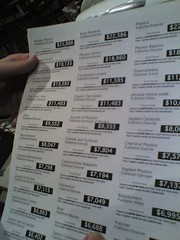
sheet of printed price tags
February 15, 2007
In recent years, the prices of scholarly journals has skyrocketed. In some disciplines, especially the sciences, the cost of a single journal subscription or access to electronic resources can cost an educational institution thousands or even tens of thousands of dollars. Of cousre, the works in these journals are completely inaccessible to the vast majority of people. Notably, this includes the taxpayers (most of us, that is) who funded the research in the first place. The few places that can afford them, places like MIT where I am a student, frequently fund research that ends up being inaccessible to their own researchers! Meanwhile, large publishers of scholarly journals are registering huge profits.
The open access scholarly publishing movement has been quietly gathering momentum over the last several years and marking a number of important successes. So called "open access" journals like those published by the Public Library of Science have begun offering compelling, publicly accessable alternatives to these closed and restrictive models of academic publishing.
In order to highlight the importance of open access, February 15, 2007 was declared National Day of Action for Open Access by freeculture.org and The Alliance for Taxpayer Access.
Inspired by the Seeing Red project at Brown a few years back, a group of other students at MIT joined me to bring attention to the open access issue and the sky-rocketing price of scholarly journals at MIT by placing overprice tags on the 100 journals that MIT pays more than $5,000 USD per year for an instituational subscription to.
The event took place over a several hours and was carried out by half a dozen students including myself. The following pictures documents some of the process and the results.
Most photos are by nic221. You can view these and more in this Flickr set.
Overprice tags are a great way to alert researchers to the ridiculous price that institutions are paying for access to scholarly works. Picking up a journal with $25,000+ USD price tags raises eyebrows. In some cases, it even outrages people. Done well, overprice tags will channel this outrage into a range of productive open access activities and pressure that will ultimately end in a more equitable arrangement for scholarly publishing.
We've already recieved several messages from people at MIT who have seen our tags and a lots of positive support. Of course, the vast majority of people affected by the lack of open access do not go to MIT. Creating "overprice tags" for journals in your academic library is an effective and fun way to help highlight the open access issue. The following section tries to document the process, so that you can run your own overprice tag event.
If you are planning a similar project, you'll need a variety of supplies. This is what we used:

That's it! Application of stickers is quite simple. Simply go to a library and stick the stickers onto journals in a place that people will see them.
Our experience was a very smooth one but we learned a few things that might qualify us to give advice to others trying to replicate the project:
Help on the project was provided by Students for Open Access at MIT, MIT Free Culture, Harvard Free Culture, and the Computing Culture Group at the MIT Media Lab.
mako — Tue, 20 Feb 2007 00:04:02 -0500